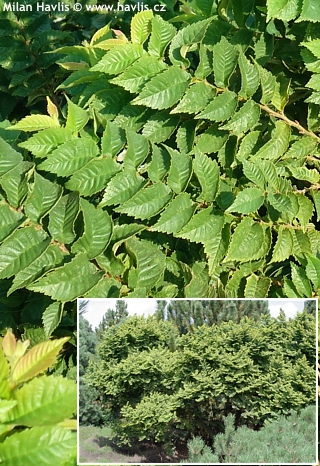Ulmus minor 'JACQUELINE HILLIER'

Ulmus minor 'JACQUELINE HILLIER'
field elm
field elm
| SIZE/TYPE | taller shrub |
|---|---|
| small tree | |
| USUAL HEIGHT | 2-4m |
| USUAL WIDTH | 2-4m |
| LEAVES | deciduous broadleaf |
| COLOUR OF LEAVES |
 green green |
| LOCATION | full to partial sun |
| SOIL TYPE | any (acidic to alkaline) |
| SOIL MOISTURE REQUIREMENTS | evenly moist but well-drained |
| USDA zone (lowest) | 5 (down to -29°C) |
| WINTER PROTECTION | |
| FOR ZONE 5+6 |

|
| FOR ZONE 7 |

|
| BELONGS TO CATEGORIES |
Deciduous broadleaf Trees |
Field elm is a tree native to areas from southern Europe to Asia Minor, but it is widely grown almost all around Europe in temperate climate. The origin of its dwarf variety Jacqueline Hillier is not quite transparent but is believed that its first specimen to have been described later by Sir Harold Hillier was found in Birmingham, England in 1966, growing in a private garden, where it was brought from abroad as a specialty.
Jacqueline Hillier (J.H. elm) is a unique elm variety, possibly a witch’s broom with small leaves, slow growth, and picturesque habit. Its deciduous leaves are medium green, alternating, only about 3 cm long, typically hornbeam-shaped: narrowly ovate, conspicuously veined and serrated at margins. They grow in a distinctive herringbone pattern. Young leaves are pale green to almost yellow green with a hint of pink and turn orange in autumn. This variety does not bloom or make seeds or produce root suckers as some of its close relatives.
Naturally, J.H. elm makes beautiful shrubs or multi-stemmed trees which look best if you remove the lateral twigs in the lower parts and reveal the uniquely twisted trunks. The canopy is rather flat-topped and very dense, almost impenetrable. J.H. elm is also grafted onto common hornbeam rootstocks making a dwarf, single-stem tree ideal for small spaces. Its height is usually around 3 meters, but several specimens that have grown twice as large have already been documented.
Elm is not picky about soil type if it is well-drained. This one prefers constant moisture, so we recommend mulching it sufficiently as a prevention from drying out during hot summer months. It is best grown in full sun in an open site where it can fully display its canopy outline. Fully hardy to about -34°C (USDA zone 4).
Last update 17-11-2021
Jacqueline Hillier (J.H. elm) is a unique elm variety, possibly a witch’s broom with small leaves, slow growth, and picturesque habit. Its deciduous leaves are medium green, alternating, only about 3 cm long, typically hornbeam-shaped: narrowly ovate, conspicuously veined and serrated at margins. They grow in a distinctive herringbone pattern. Young leaves are pale green to almost yellow green with a hint of pink and turn orange in autumn. This variety does not bloom or make seeds or produce root suckers as some of its close relatives.
Naturally, J.H. elm makes beautiful shrubs or multi-stemmed trees which look best if you remove the lateral twigs in the lower parts and reveal the uniquely twisted trunks. The canopy is rather flat-topped and very dense, almost impenetrable. J.H. elm is also grafted onto common hornbeam rootstocks making a dwarf, single-stem tree ideal for small spaces. Its height is usually around 3 meters, but several specimens that have grown twice as large have already been documented.
Elm is not picky about soil type if it is well-drained. This one prefers constant moisture, so we recommend mulching it sufficiently as a prevention from drying out during hot summer months. It is best grown in full sun in an open site where it can fully display its canopy outline. Fully hardy to about -34°C (USDA zone 4).
Last update 17-11-2021
SIZES and PRICES
CURRENTLY SOLD OUT
GLOSSARY
|









